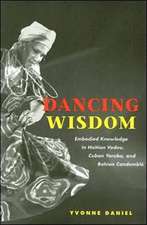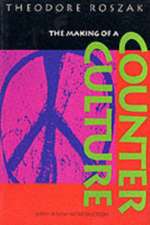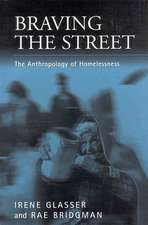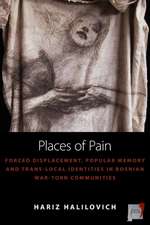We Are the Face of Oaxaca – Testimony and Social Movements
Autor Lynn Stephenen Limba Engleză Hardback – 15 oct 2013
| Toate formatele și edițiile | Preț | Express |
|---|---|---|
| Paperback (1) | 301.20 lei 6-8 săpt. | |
| Duke University Press – 15 oct 2013 | 301.20 lei 6-8 săpt. | |
| Hardback (1) | 639.02 lei 6-8 săpt. | |
| MD – Duke University Press – 15 oct 2013 | 639.02 lei 6-8 săpt. |
Preț: 639.02 lei
Preț vechi: 788.92 lei
-19% Nou
Puncte Express: 959
Preț estimativ în valută:
122.29€ • 132.79$ • 102.72£
122.29€ • 132.79$ • 102.72£
Carte tipărită la comandă
Livrare economică 22 aprilie-06 mai
Preluare comenzi: 021 569.72.76
Specificații
ISBN-13: 9780822355199
ISBN-10: 0822355191
Pagini: 368
Ilustrații: 26 photographs, 1 table, 4 maps
Dimensiuni: 152 x 229 x 15 mm
Greutate: 0.64 kg
Editura: MD – Duke University Press
ISBN-10: 0822355191
Pagini: 368
Ilustrații: 26 photographs, 1 table, 4 maps
Dimensiuni: 152 x 229 x 15 mm
Greutate: 0.64 kg
Editura: MD – Duke University Press
Recenzii
"We Are the Face of Oaxaca is a magnificent book. A model of engaged scholarship and the best work yet by Lynn Stephen, it is an original analysis of the massive popular rebellion in Oaxaca, Mexico, during 2006-07. Given her deep, long-term ties to Oaxacans in both Mexico and the United States, Stephen is uniquely positioned to analyze the social movement and the significance of participants' testimonials in its production and reception."Patricia Zavella, author of I'm Neither Here nor There: Mexicans' Quotidian Struggles with Migration and Poverty"Given the new visibility of protest, Lynn Stephen's fascinating book offers a valuable opportunity to understand how protest movements work at the grassroots. This ethnography of the Oaxacan protest of 2006 focuses on testimony: the performed, embodied act of telling a story. Protesters courageous testimonies broadcast over the radio made a difference. The book and its website with recordings provide a wonderful opportunity to hear the testimonies of those with courage to speak."Sally Engle Merry, author of Human Rights and Gender Violence: Translating International Law into Local Justice
"We Are the Face of Oaxaca is a magnificent book. A model of engaged scholarship and the best work yet by Lynn Stephen, it is an original analysis of the massive popular rebellion in Oaxaca, Mexico, during 2006-07. Given her deep, long-term ties to Oaxacans in both Mexico and the United States, Stephen is uniquely positioned to analyze the social movement and the significance of participants' testimonials in its production and reception." - Patricia Zavella, author of I'm Neither Here nor There: Mexicans' Quotidian Struggles with Migration and Poverty "Given the new visibility of protest, Lynn Stephen's fascinating book offers a valuable opportunity to understand how protest movements work at the grassroots. This ethnography of the Oaxacan protest of 2006 focuses on testimony: the performed, embodied act of telling a story. Protesters' courageous testimonies broadcast over the radio made a difference. The book and its website with recordings provide a wonderful opportunity to hear the testimonies of those with courage to speak." - Sally Engle Merry, author of Human Rights and Gender Violence: Translating International Law into Local Justice
"We Are the Face of Oaxaca is a magnificent book. A model of engaged scholarship and the best work yet by Lynn Stephen, it is an original analysis of the massive popular rebellion in Oaxaca, Mexico, during 2006-07. Given her deep, long-term ties to Oaxacans in both Mexico and the United States, Stephen is uniquely positioned to analyze the social movement and the significance of participants' testimonials in its production and reception." - Patricia Zavella, author of I'm Neither Here nor There: Mexicans' Quotidian Struggles with Migration and Poverty "Given the new visibility of protest, Lynn Stephen's fascinating book offers a valuable opportunity to understand how protest movements work at the grassroots. This ethnography of the Oaxacan protest of 2006 focuses on testimony: the performed, embodied act of telling a story. Protesters' courageous testimonies broadcast over the radio made a difference. The book and its website with recordings provide a wonderful opportunity to hear the testimonies of those with courage to speak." - Sally Engle Merry, author of Human Rights and Gender Violence: Translating International Law into Local Justice
Notă biografică
Cuprins
Maps, Illustrations, and Videoclips vii
Acronyms and Abbreviations xi
About the Website xv
Acknowledgments xvii
1. Testimony: Human Rights, and Social Movements 1
2. Histories and Movements: Antecedents to the Social Movement of 2006 36
3. The Emergence of the APPO and the 2006 Oaxaca Social Movement 66
4. Testimony and Human Rights Violations in Oaxaca 95
5. Community and Indigenous Radio in Oaxaca: Testimony and Participatory Democracy 121
6. The Women's Takeover of Media in Oaxaca: Gendered Rights "to Speak" and "to Be Heard" 145
7. The Economics and Politics of Conflict: Perspectives from Oaxacan Artisans, Merchants, and Business Owners 178
8. In Indigenous Activism: The Triqui Autonomous Municipality, APPO Juxtlahuaca, and Transborder Organizing in AAPO-L.A. 209
9. From Barricades to Autonomy and Art: Youth Organizing in Oaxaca 245
Conclusions 276
Notes 289
Bibliography 303
Index 323
Acronyms and Abbreviations xi
About the Website xv
Acknowledgments xvii
1. Testimony: Human Rights, and Social Movements 1
2. Histories and Movements: Antecedents to the Social Movement of 2006 36
3. The Emergence of the APPO and the 2006 Oaxaca Social Movement 66
4. Testimony and Human Rights Violations in Oaxaca 95
5. Community and Indigenous Radio in Oaxaca: Testimony and Participatory Democracy 121
6. The Women's Takeover of Media in Oaxaca: Gendered Rights "to Speak" and "to Be Heard" 145
7. The Economics and Politics of Conflict: Perspectives from Oaxacan Artisans, Merchants, and Business Owners 178
8. In Indigenous Activism: The Triqui Autonomous Municipality, APPO Juxtlahuaca, and Transborder Organizing in AAPO-L.A. 209
9. From Barricades to Autonomy and Art: Youth Organizing in Oaxaca 245
Conclusions 276
Notes 289
Bibliography 303
Index 323















